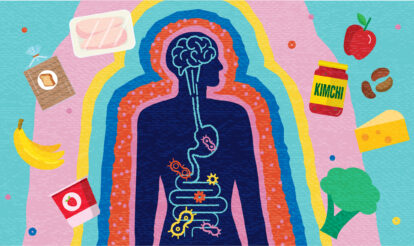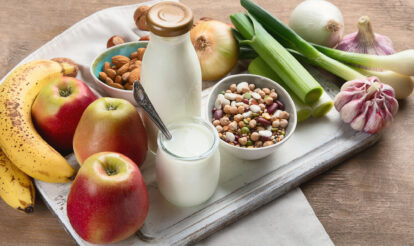
Feeding your microbiome: Microbiota-friendly foods and meal plan
Feeding your microbiome: Microbiota-friendly foods and meal plan

If you’ve been hearing and reading more about the importance of gut health, there’s a good reason. Your gut or large intestine is home to trillions of microscopic organisms that include bacteria, yeasts, and other microbes. They’re known as your microbiota, the community of microorganisms that make up your gut microbiome.
These microbes are more than just passive residents. Scientists have learned that the microbiota is vital in supporting digestive, immune, and overall health. Therefore, it’s crucial that you do your best to support and nurture the trillions of tiny lives residing in your gut. One of the best ways to do that is by feeding them the proper diet.
What does your microbiota do?
Beneficial bacteria in your gut work hard all day and night to support your health. They produce essential micronutrients like vitamin K, B12, and other B vitamins. Your gut microbiota also supports your immune system by crowding out harmful pathogens and strengthening your gut lining so toxins won’t leak into your bloodstream.1
In addition, bacteria in your gut help break down indigestible fibre from plant foods like fruits, vegetables, grains, and legumes by fermenting it. In doing so, they produce compounds called short-chain fatty acids (SFAs). These compounds have many health benefits, including nourishing the cells in your large intestine and supporting metabolic health.1
Researchers note that a diverse microbiota, with a wide variety of beneficial bacteria and other microbes, is a sign of a healthy gut.1 One of the best ways to promote more diversity is through diet.2 In fact, it’s possible to improve the diversity in your microbiota within a few days simply by improving your diet.2
Foods that support gut health
Your microbiota thrives on fibre, the part of carbohydrate foods the body can’t digest. Compounds in fibre stimulate the growth and activity of beneficial bacteria in your gut. Over time, eating a high-fibre diet changes the composition of microbes, promoting more richness and diversity in your microbiota. Different species of bacteria break down different fibre types, so eating a wide variety of fibre foods is helpful.3 Some of their preferred sources of fuel include:
- Fruits like apples, bananas (especially green/underripe ones), nectarines, and peaches
- Vegetables like leafy greens, asparagus, fennel bulb, green peas, snow peas, onions, garlic, and leeks
- Whole grains like barley, buckwheat, wheat bran, rye, and oats
- Legumes like chickpeas, lentils, kidney, cannellini, and black beans
- Nuts and seeds like almonds, walnuts, cashews, pistachios, and sunflower seeds
Cultured and fermented foods also support your microbiota. These are sources of the same types of live cultures found in your gut, so eating and drinking these foods can enrich your microbiota:
- Yoghurt
- Kefir (fermented milk)
- Cultured cream cheese or sour cream
- Sauerkraut
- Kimchee (fermented vegetables)
- Fermented pickles or other vegetables
- Kombucha (fermented tea)
A meal plan for your gut
These meals and snacks include many microbiota-friendly foods. Use these as suggestions to help you learn to incorporate foods that support your microbiota. Feel free to mix, match, and adapt these meals to your tastes and dietary needs.
Breakfasts
- Muesli with oats, sliced almonds, dried cranberries, and plain Greek yoghurt
- Green banana smoothie with unsweetened kefir and almond butter
- Omelet with sauteed onions, garlic, and asparagus
- Buckwheat pancakes topped with canned diced, unsweetened peaches
Lunches
- Homemade white bean and vegetable soup* with whole wheat crackers
- Turkey roll-up sandwich on whole grain lavash, spread with hummus and served with a side of sauerkraut
- Whole wheat flatbread pesto and tomato pizza*
- Rye toast spread with cultured cream cheese, smoked salmon, and sliced onion
Snacks
- Yoghurt parfait layered with granola and fresh fruit
- Rye crackers served with white bean and garlic dip, raw carrot and red pepper strips, and fermented pickles Apple slices topped with nut butter and a sprinkle of sunflower seeds
Dinners
- Grilled fish, leafy greens sauteed with garlic and leeks, and barley pilaf
- Chicken shawarma* served with whole grain pita and Greek yoghurt tzatziki sauce
- Mixed roasted vegetables with lentils and tahini sauce
- Egg frittata with leeks, asparagus, and sundried tomatoes*
Recipes
Homemade White Bean and Vegetable Soup makes 2 servings
- 1 tablespoon olive oil
- 4 tablespoons minced onion
- 1 clove garlic, minced
- 2 medium carrots, chopped
- 1 stalk celery, chopped
- 946 ml chicken or vegetable stock from a carton
- 1 (439 g) can white beans, drained and rinsed
Directions:
- Heat the olive oil in a large saucepan over medium-high heat. Add the onion, garlic, carrots, and celery, and saute for 4 minutes.
- Add the chicken or vegetable stock and white beans to the pot.
- Bring the soup to a boil, then reduce the heat to medium-low, cover, and simmer for 30 minutes or until the vegetables are tender.
Whole Wheat Flatbread Pesto and Tomato Pizza makes 1 serving
- 1 piece whole wheat flatbread or naan
- 2 tablespoons prepared pesto sauce
- 3-4 fresh tomato slices
- 60g shredded mozzarella
Directions:
- Heat the oven broiler to high. Place the flatbread or naan on a baking sheet. Toast one side under the broiler until the bread is lightly golden.
- Remove the bread from the oven and flip it over.
- On the untoasted side, spread with 2 tablespoons of pesto sauce. Top the pesto sauce with tomato slices and sprinkle the cheese over.
- Return the pizza to the broiler and cook until the cheese is melted and bubbly (about 2 minutes).
Chicken Shawarma with Tzatziki Sauce makes 2 servings
Chicken:
- 2 tablespoons fresh lemon juice
- 1 tablespoon olive oil
- 2 garlic cloves, minced
- 1 teaspoon cumin
- 1 teaspoon paprika
- ½ teaspoon turmeric
- Pinch of black pepper
- Pinch of salt
- Pinch of cinnamon
- 227 g thinly sliced boneless, skinless chicken breast
Tzatziki Sauce:
- 120 ml Greek yoghurt
- 3 tablespoons minced cucumber
- Salt and pepper to taste
- 1 tablespoon minced parsley
For Serving:
- 2 pieces whole wheat pita
- Chopped vegetables (cucumbers, olives, tomatoes, red onion)
Directions:
- In a mixing bowl, combine the lemon juice, olive oil, garlic, cumin, paprika, turmeric, black pepper, salt, and cinnamon.
- Add the chicken and toss to coat well with the spice mix. Let the chicken marinate for at least 30 minutes
- While the chicken marinates, make the tzatziki sauce by combining the Greek yoghurt, minced cucumbers, salt, pepper, and parsley. Set the sauce aside in the refrigerator.
- Heat a grill to medium-high heat. Grill the chicken for about 3 minutes per side or until cooked through.
- To serve, place half the chicken in the centre of each pita. Top with tzatziki sauce and chopped vegetables.
Egg Frittata with Leeks, Asparagus, and Sundried Tomatoes makes 2 servings
- 4 large eggs
- 2 tablespoons milk
- ½ teaspoon dijon mustard
- Salt and pepper
- 1 tablespoon olive oil
- 1 medium leek (green parts only, sliced thin)
- 100g trimmed asparagus, cut into 2 cm pieces
- 2 tablespoons sundried tomatoes in olive oil, drained and minced
Directions:
- Whisk the eggs, milk, and mustard together in a mixing bowl. Season with salt and pepper. Set the egg mixture aside.
- Heat the olive oil in a small nonstick frying pan over medium-high heat. Add the leeks, asparagus, and sundried tomatoes. Saute the vegetables for 4 minutes.
- Pour the egg mixture over the vegetables. Reduce the heat to medium and let the frittata cook until the eggs are set, 5-10 minutes.
References
- Valdes AM, Walter J, Segal E, Spector TD. Role of the gut microbiota in nutrition and health. BMJ. 2018 Jun 13;361:k2179. doi: 10.1136/bmj.k2179.https://www.bmj.com/content/361/bmj.k2179
- Sonnenburg JL, Bäckhed F. Diet-microbiota interactions as moderators of human metabolism. Nature. 2016 Jul 7;535(7610):56-64. doi: 10.1038/nature18846. https://www.ncbi.nlm.nih.gov/pmc/articles/PMC5991619/
- Cronin P, Joyce SA, O’Toole PW, O’Connor EM. Dietary Fibre Modulates the Gut Microbiota. Nutrients. 2021 May 13;13(5):1655. doi: 10.3390/nu13051655. https://www.ncbi.nlm.nih.gov/pmc/articles/PMC8153313/




